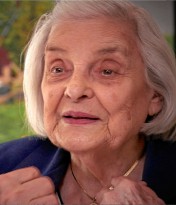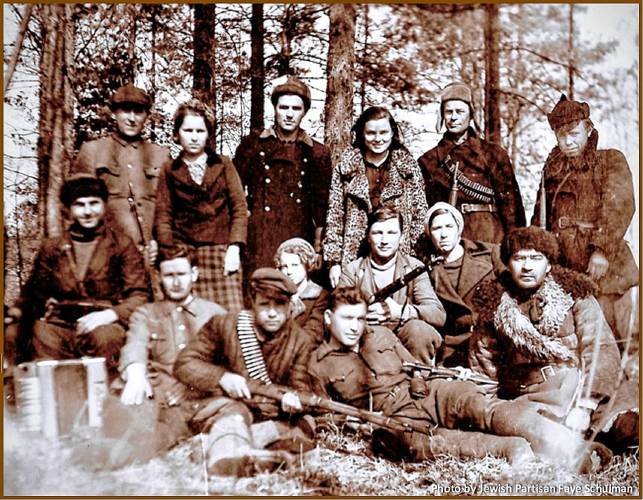‘Labor of love” might be a cliche. But when it comes to her new film, “Four Winters: A Story of Jewish Partisan Resistance and Bravery During WWII,” Julia Mintz says the expression is very much appropriate.
Mintz, a documentary filmmaker who splits her time between Northampton and New York City, began work on “Four Winters” over a decade ago, after reading about how armed bands of Jews fought the Nazis in the forests of eastern Europe. It was a chapter of the war and the Holocaust she hadn’t known much about before, she says.
Now, after working on the documentary for years in between other projects, Mintz and her production team, including a number of Valley filmmakers, have debuted “Four Winters” in the last several months to considerable acclaim in the Berkshires, New York, Canada, and a number of other locales.
And on April 19, they’ll bring the film to Northampton’s Academy of Music — a fitting place, says Mintz, the movie’s director and writer, as much of the documentary was finalized here in the city, in her home studio.
“This really was a passion project for me,” Mintz said during a recent call from the road as she was on her way back to the Northeast after screening “Four Winters” in Toronto. “So to be able to show the finished work that we did right here in the Valley is really exciting.”
The documentary is built around interviews with eight former Jewish partisans, all in their 90s or approaching them, as well as extensive use of old photos and film footage, which Mintz says came from range of historical archives as well as the personal collections of surviving partisans and their families.
It’s a story told almost entirely through the voices of the eight interviewees, and as such it packs an emotional punch, as these elderly fighters relate how the Germans killed many of their family members — children, husbands, mothers, fathers, sisters and brothers — while they barely cheated death themselves.

Yet the interviewees, then in their late teens or early 20s, managed to escape Jewish ghettos in Lithuania, Belarus, and what was then eastern Poland to establish camps in the woods and live rough, scrounging for food and basic survival.
Eventually they acquired weapons, learned how to use them, and began ambushing German supply columns, blowing up trains, and destroying rail lines and bridges, forcing the Nazis to devote significant resources to combat them; sometimes they fought pitched battles against German troops.
Mintz says that “stark juxtaposition” of the partisans going from seeming victims to hardened, disciplined fighters who took on “the Nazi war machine” is at the heart of the story.
“They did something that was so far outside their own lives and experience, and they did it under the most terrifying and brutal circumstances,” she said. “But they could also see a better future. They continued to believe in humanity — they showed true Jewish spirit.”
Making an ‘upside-down’ film
Mintz has worked in different capacities on numerous other films, including “Get Me Roger Stone,” an acclaimed 2017 documentary about the Republican gadfly and Donald Trump adviser. But for “Four Winters,” she says she had to throw out the typical playbook for making a documentary.
“This film was basically built upside down,” she said, describing how she began arranging interviews with surviving Jewish partisans before she really had any idea how a movie about them might be structured.
Given the advanced age of the survivors, Mintz noted, “It was a race against time.”
Sadly, in fact, just one of the eight interviewees in “Four Winters” is still alive, she says: Michael Stoll, a native of Poland who today lives in Berkshire County and is in his late 90s.
Mintz and her team interviewed “dozens of people” across many locales, including in the U.S., Canada, Europe and Israel. They settled on the eight interviewees, Mintz said, in part because, aside from the richness of their personal stories, their experiences well represented the collective dynamic of the approximately 25,000 Jewish partisans who battled the Nazis in eastern Europe.
Those personal stories also reflect the larger horror of the Holocaust, which accelerated in the summer of 1941 after the Germans attacked the former Soviet Union, overrunning places such as eastern Poland and the Baltic states previously occupied by the Soviets. In those territories, the Nazis almost immediately began mass shootings of Jews.
Faye Shulman, who grew up in Poland, describes how her entire family was rounded up one day and, with hundreds of other Jews, shot to death. Through the action of a German officer that she didn’t really understand, she was spared, but she witnessed some of the executions — from the roof of a synagogue, she said.
“I heard the shooting, I heard the crying, I heard everything,” she says, her voice breaking. “And I didn’t want to stay alive by myself … I wanted to die with my family.”
Her testimony is mixed with frightening photos the Nazis took themselves of ranks of people being shot and mounds of corpses in mass graves, with a soundtrack of ominous ambient music.
Yet later in the film, Shulman describes how she fled to the woods with other Jewish survivors and learned how to shoot a rifle and fight back.
“The pillow was the rifle, the walls were the trees, and the sky was the roof,” she says of this sylvan existence. One of her few possessions was a camera, which she used to record some of the partisans’ actions. (Many of her photos appear in the film, and there are also some of her as a young woman.)
Stoll says his decision to resist began with jumping off a train on which he and many other Jews were being taken to a “work camp,” according to the Nazis. Stoll didn’t believe it and urged others to join him.
“Where do you think you’re going?” he recalls saying. “You think you’re going to a picnic or something? We know they’re going to kill us. The longer we wait, the shorter our lifespan.”
The film’s power comes from seeing how Stoll and the other partisans, despite their youth and their devastating personal losses, became determined fighters who could be as merciless to the Germans as the Germans were to the Jews: “Revenge is the meaning of our lives now,” says one.
Frank Blaichman, a native of Poland, also notes that he and his fellow partisans didn’t hesitate to take on civilians who worked with the Nazis: He describes, in a matter-of-fact voice, how in one early mission, “We cleaned out the area of the collaborators.”
Mintz says “Four Winters,” on one level, helps dispel the myth of Jewish passivity in the face of Nazi violence. She also believes the film “gives us a much broader understanding of what happened during the war.”
Perhaps even more important, she says, is the way the film speaks to current concerns, when growing incidents of antisemitism have been reported worldwide and authoritarianism becomes more common in certain countries.
“I think the [partisans’] story of resistance is very relevant today, whether it’s Ukraine fighting against invasion or people fighting against authoritarian regimes,” she said. “There is a common theme here — ordinary people finding the courage and determination to rise up against injustice and brutality.”
“Four Winters” will screen at the Academy of Music April 19 at 6:30 p.m. A reception with the filmmakers, with cocktails and appetizers, will follow afterward for those making an additional donation to help advance educational initiatives with the film.
Steve Pfarrer can be reached at spfarrer@gazettenet.com.


























